Abstract
C3 nephritic factor (C3NeF) was used to assess the formation of the fluid-phase amplification convertase, C3b,Bb, in 37 serum specimens from 24 patients with systemic lupus erythematosus (SLE). C3b,Bb formation was measured by the concentration of Ba, released when C3b,B is activated. Incubation of normal human serum (NHS) with C3NeF accelerates C3b amplification loop turnover with the formation of large quantities of C3b,Bb. In contrast, sera from 22 of 24 patients with SLE formed little or no convertase when incubated with C3NeF. C3 conversion to C3b was commensurately reduced. The inhibition could not be attributed to depressed serum concentrations of C3, factor B, or classical pathway components. Inhibitor present in excess could be demonstrated in 23 of 34 specimens of SLE serum by mixing experiments. The spontaneous convertase formation that occurs when a portion of the serum H is inactivated with F(ab')2 anti-H was also shown to be inhibited in SLE serum. The inhibition was found, however, to be H dependent in that convertase formation was normal in SLE serum depleted of H. It is concluded that the C3b in most SLE sera is unusually susceptible to inactivation by H, but a functional abnormality was not demonstrable in either C3 or H isolated from SLE serum. The inhibition could be simulated in NHS by addition of heparin, 100 micrograms/ml. In vivo, inhibition of convertase formation could interfere with the solubilization and disposal of immune complexes by reducing the deposition of C3b on the immune complex lattice.
Full text
PDF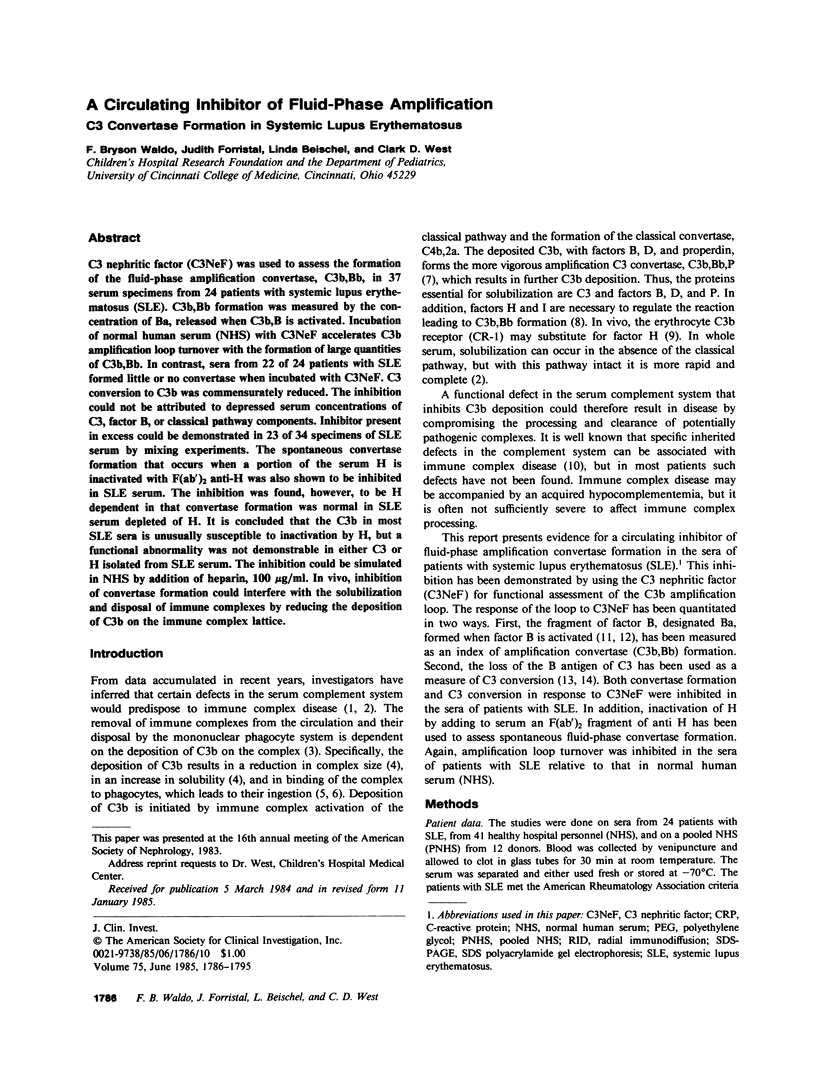
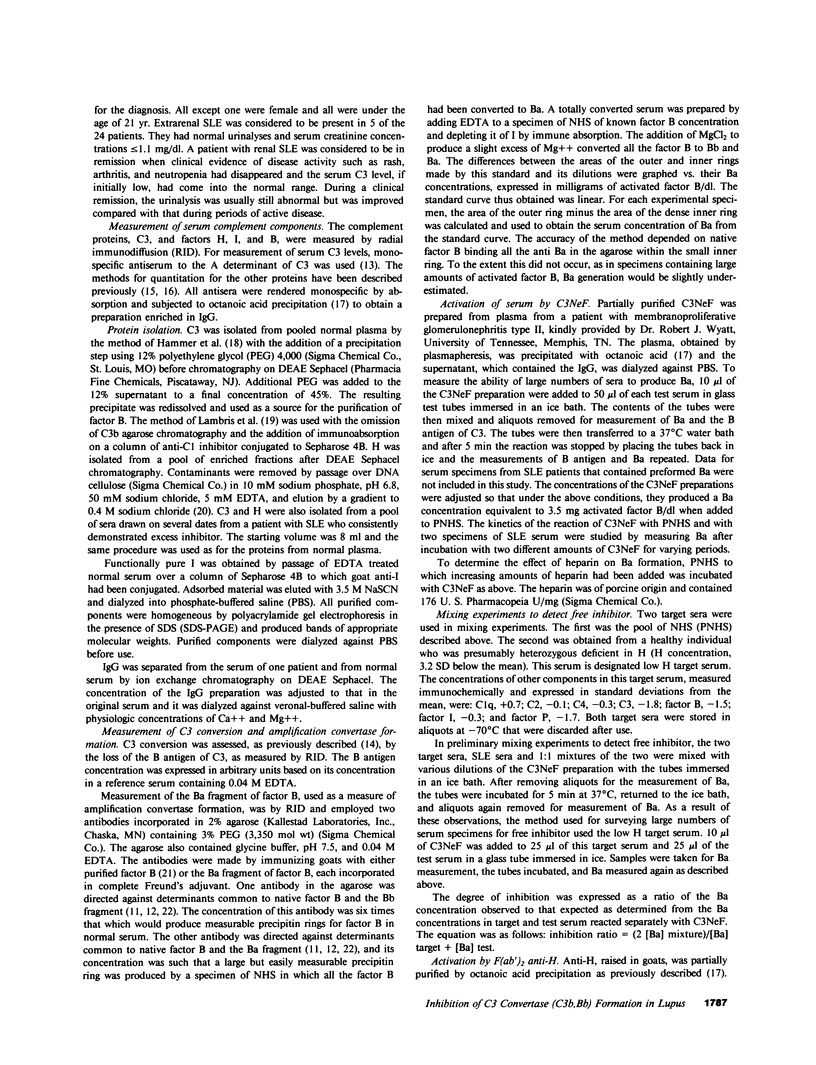
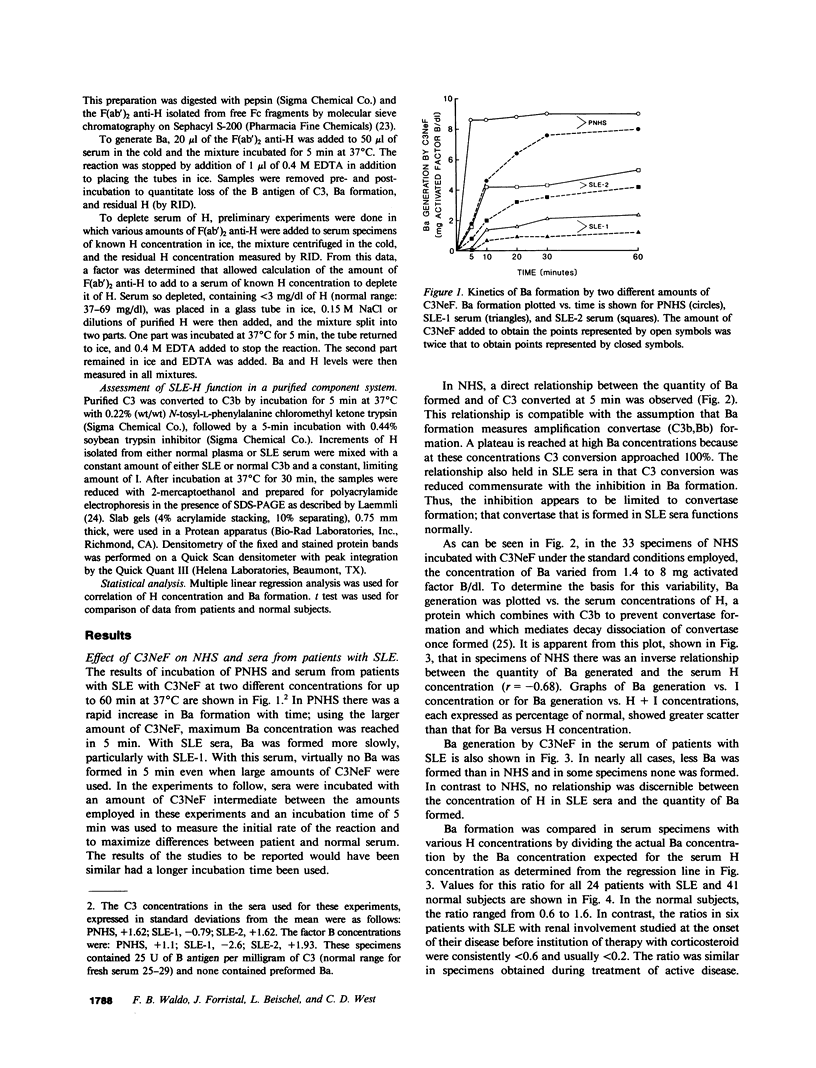
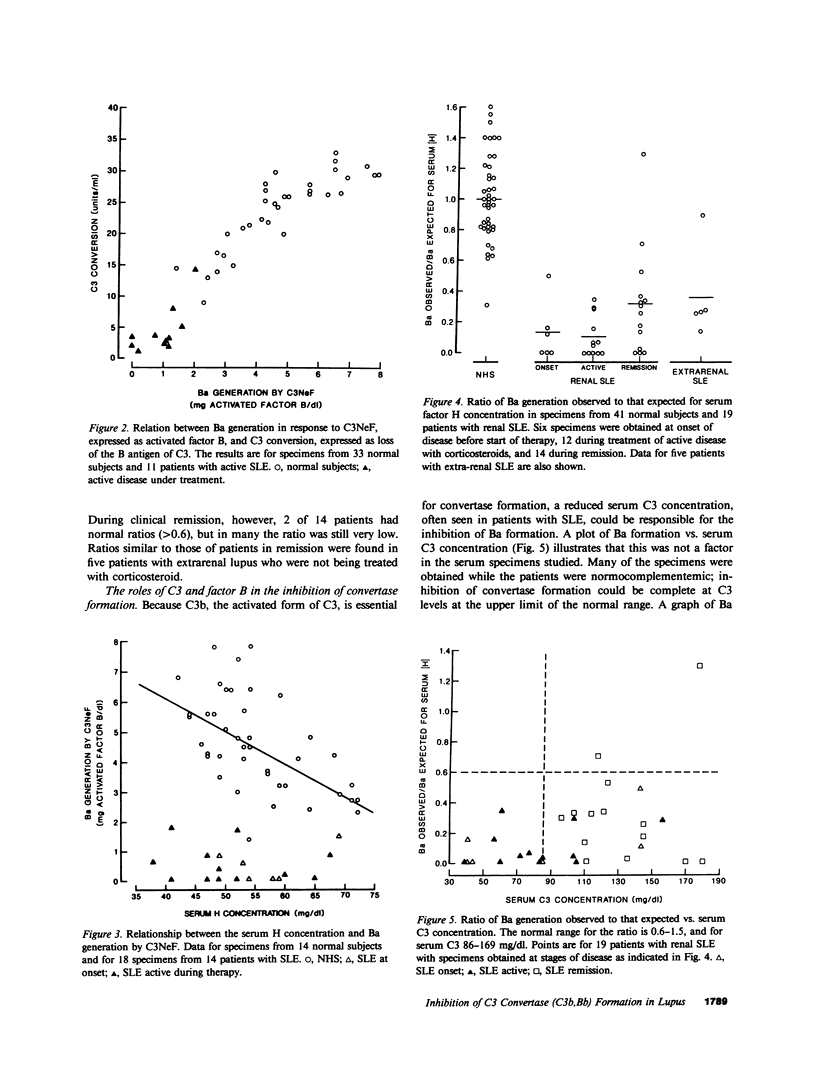
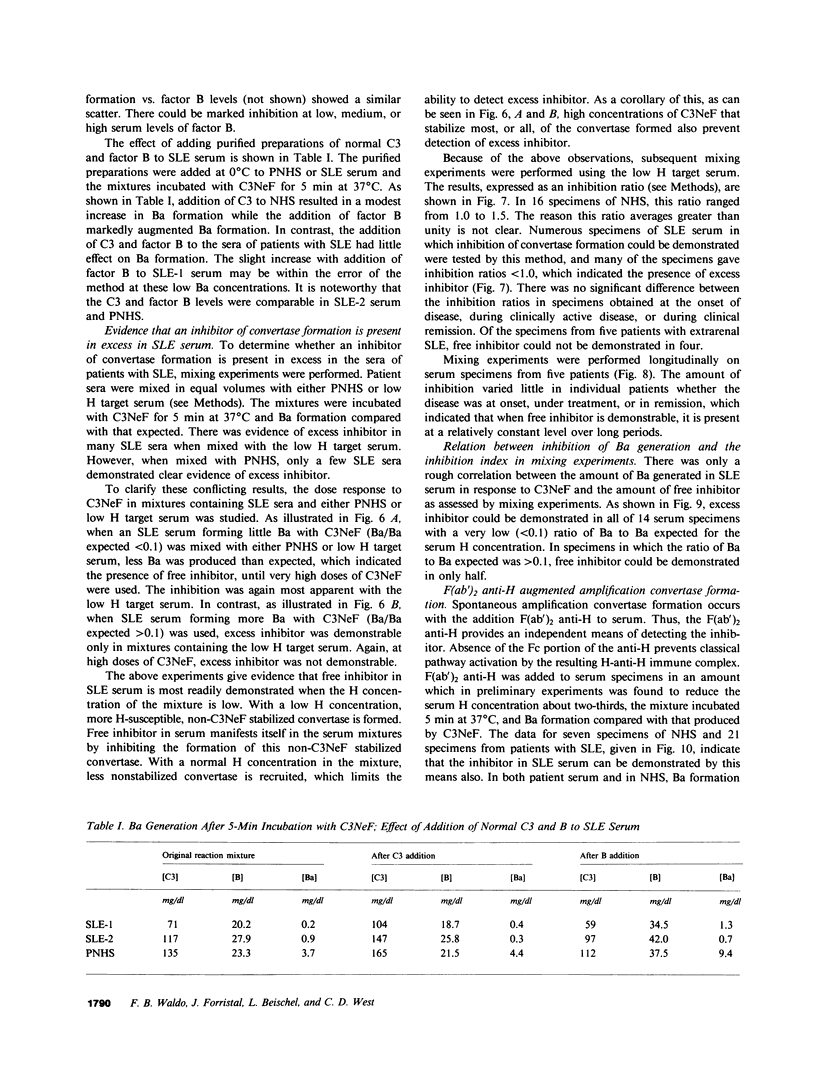
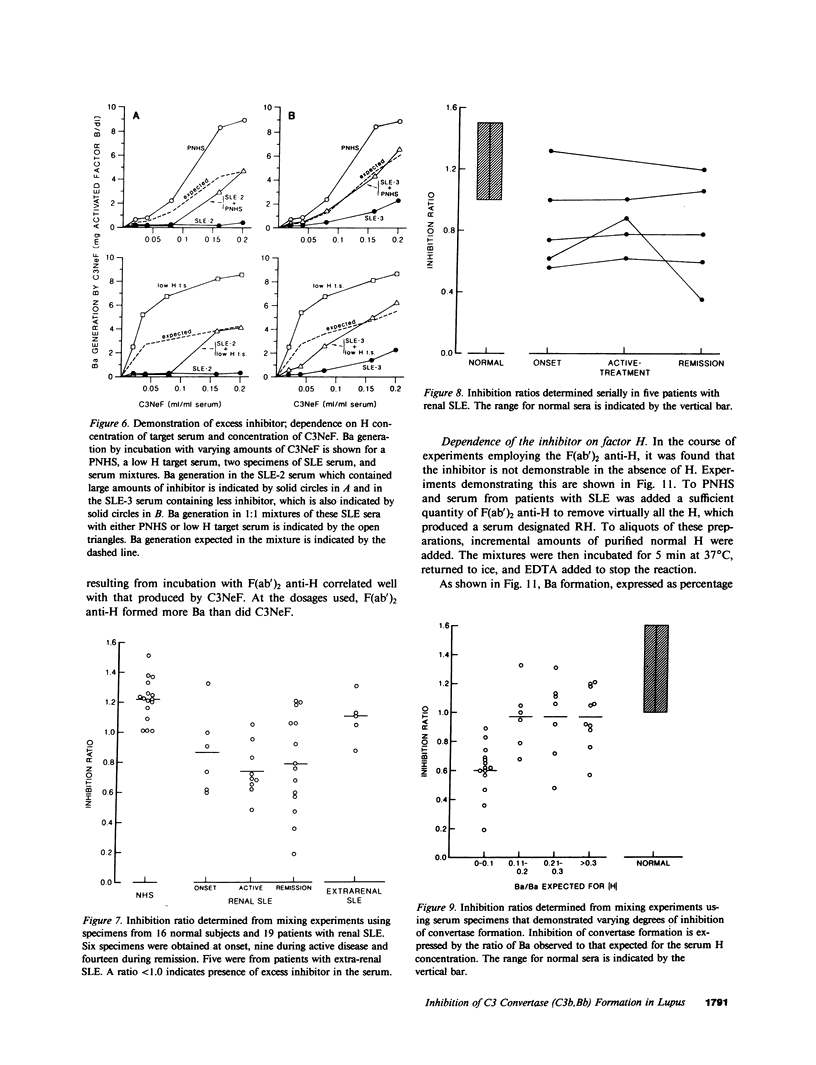
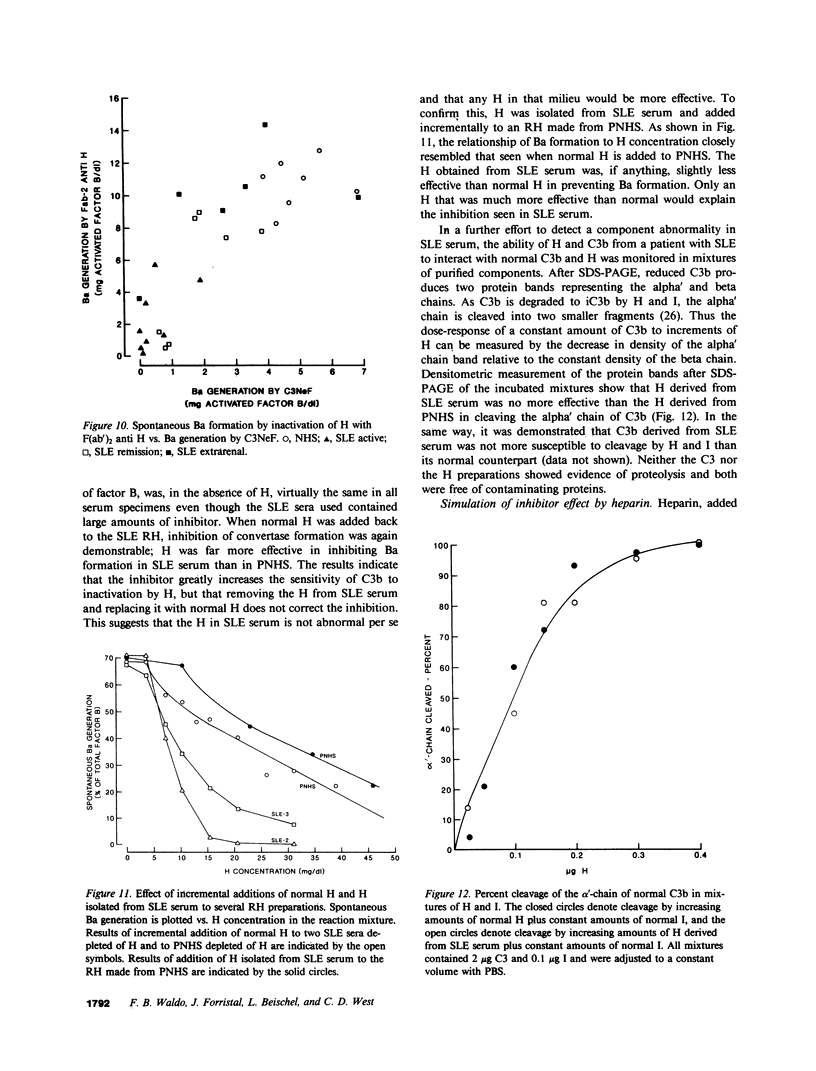
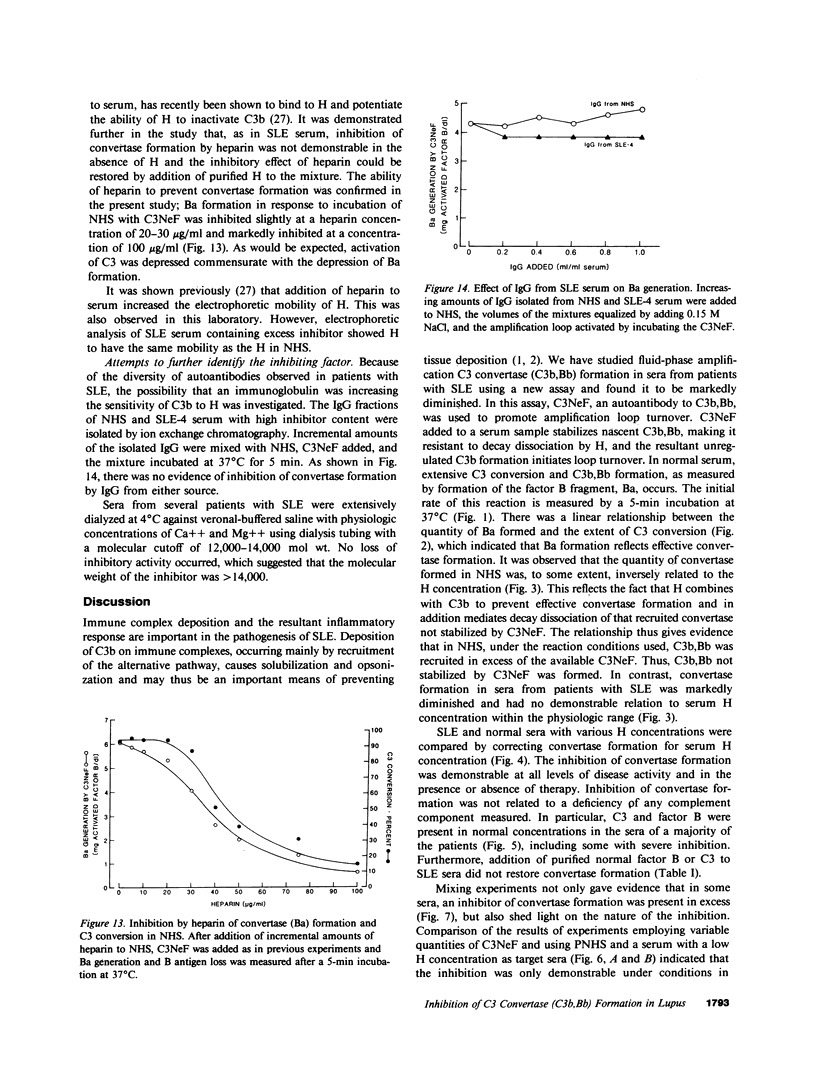
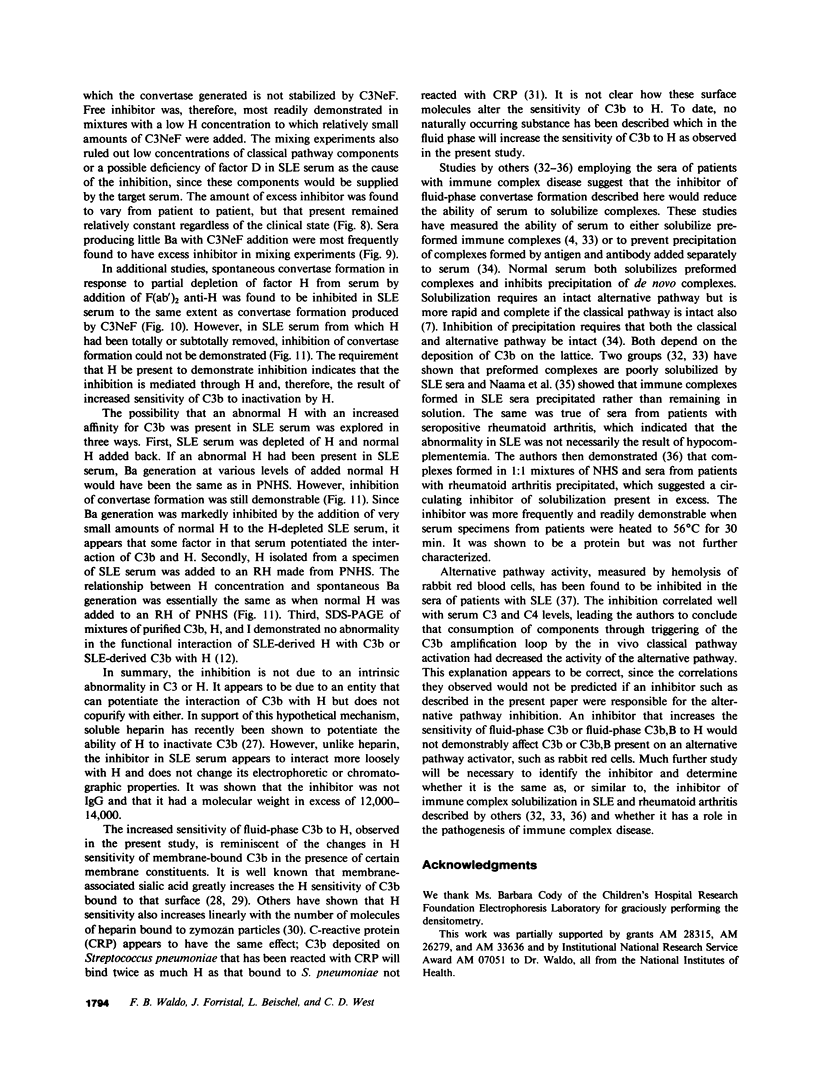
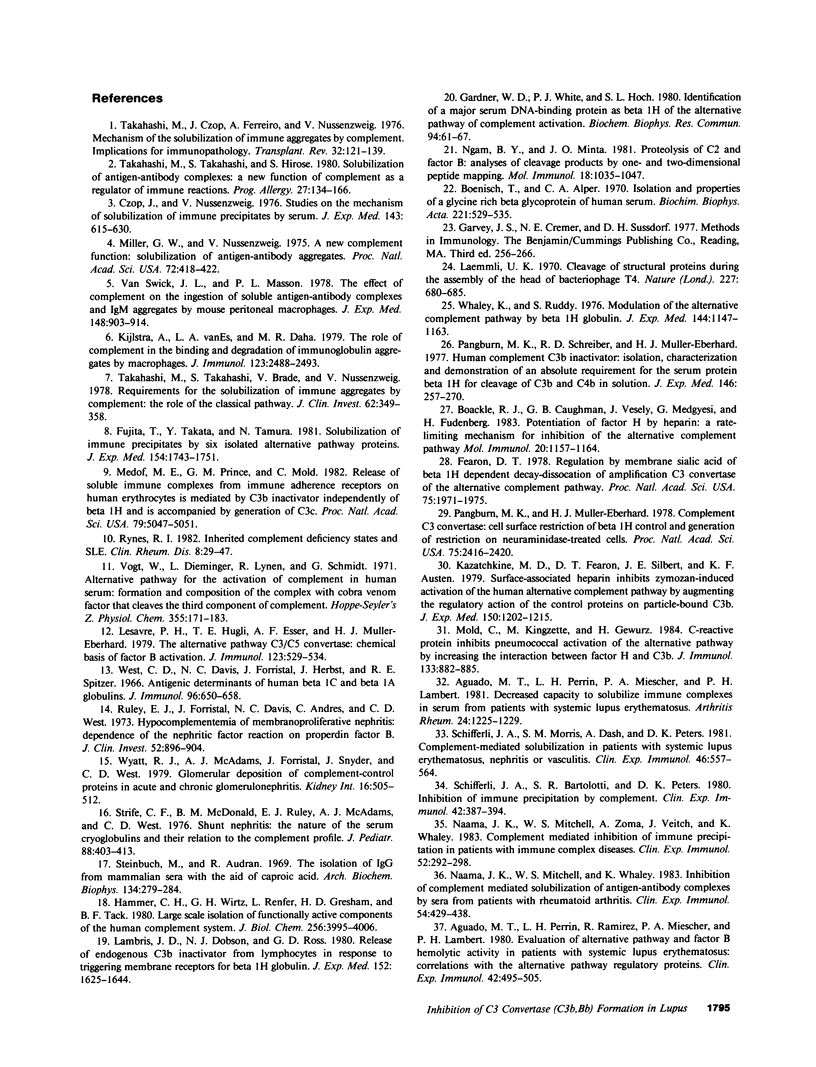
Selected References
These references are in PubMed. This may not be the complete list of references from this article.
- Aguado M. T., Perrin L. H., Miescher P. A., Lambert P. H. Decreased capacity to solubilize immune complexes in sera from patients with systemic lupus erythematosus. Arthritis Rheum. 1981 Oct;24(10):1225–1229. doi: 10.1002/art.1780241001. [DOI] [PubMed] [Google Scholar]
- Aguado M. T., Perrin L. H., Ramirez R., Miescher P. A., Lambert P. H. Evaluation of alternative pathway and factor B haemolytic activities in patients with systemic lupus erythematosus: correlations with the alternative pathway regulatory proteins. Clin Exp Immunol. 1980 Dec;42(3):495–505. [PMC free article] [PubMed] [Google Scholar]
- Boackle R. J., Caughman G. B., Vesely J., Medgyesi G., Fudenberg H. H. Potentiation of factor H by heparin: a rate-limiting mechanism for inhibition of the alternative complement pathway. Mol Immunol. 1983 Nov;20(11):1157–1164. doi: 10.1016/0161-5890(83)90139-6. [DOI] [PubMed] [Google Scholar]
- Boenisch T., Alper C. A. Isolation and properties of a glycine-rich beta-glycoprotein of human serum. Biochim Biophys Acta. 1970 Dec 22;221(3):529–535. doi: 10.1016/0005-2795(70)90224-2. [DOI] [PubMed] [Google Scholar]
- Czop J., Nussenzweig V. Studies on the mechanism of solubilization of immune precipitates by serum. J Exp Med. 1976 Mar 1;143(3):615–630. doi: 10.1084/jem.143.3.615. [DOI] [PMC free article] [PubMed] [Google Scholar]
- Fearon D. T. Regulation by membrane sialic acid of beta1H-dependent decay-dissociation of amplification C3 convertase of the alternative complement pathway. Proc Natl Acad Sci U S A. 1978 Apr;75(4):1971–1975. doi: 10.1073/pnas.75.4.1971. [DOI] [PMC free article] [PubMed] [Google Scholar]
- Fujita T., Takata Y., Tamura N. Solubilization of immune precipitates by six isolated alternative pathway proteins. J Exp Med. 1981 Dec 1;154(6):1743–1751. doi: 10.1084/jem.154.6.1743. [DOI] [PMC free article] [PubMed] [Google Scholar]
- Gardner W. D., White P. J., Hoch S. O. Identification of a major human serum DNA-binding protein as beta 1H of the alternative pathway of complement activation. Biochem Biophys Res Commun. 1980 May 14;94(1):61–67. doi: 10.1016/s0006-291x(80)80187-2. [DOI] [PubMed] [Google Scholar]
- Hammer C. H., Wirtz G. H., Renfer L., Gresham H. D., Tack B. F. Large scale isolation of functionally active components of the human complement system. J Biol Chem. 1981 Apr 25;256(8):3995–4006. [PubMed] [Google Scholar]
- Kazatchkine M. D., Fearon D. T., Silbert J. E., Austen K. F. Surface-associated heparin inhibits zymosan-induced activation of the human alternative complement pathway by augmenting the regulatory action of the control proteins on particle-bound C3b. J Exp Med. 1979 Nov 1;150(5):1202–1215. doi: 10.1084/jem.150.5.1202. [DOI] [PMC free article] [PubMed] [Google Scholar]
- Kijlstra A., van Es L. A., Daha M. R. The role of complement in the binding and degradation of immunoglobulin aggregates by macrophages. J Immunol. 1979 Dec;123(6):2488–2493. [PubMed] [Google Scholar]
- Laemmli U. K. Cleavage of structural proteins during the assembly of the head of bacteriophage T4. Nature. 1970 Aug 15;227(5259):680–685. doi: 10.1038/227680a0. [DOI] [PubMed] [Google Scholar]
- Lambris J. D., Dobson N. J., Ross G. D. Release of endogenous C3b inactivator from lymphocytes in response to triggering membrane receptors for beta 1H globulin. J Exp Med. 1980 Dec 1;152(6):1625–1644. doi: 10.1084/jem.152.6.1625. [DOI] [PMC free article] [PubMed] [Google Scholar]
- Lesavre P. H., Hugli T. E., Esser A. F., Müller-Eberhard H. J. The alternative pathway C3/C5 convertase: chemical basis of factor B activation. J Immunol. 1979 Aug;123(2):529–534. [PubMed] [Google Scholar]
- Medof M. E., Prince G. M., Mold C. Release of soluble immune complexes from immune adherence receptors on human erythrocytes is mediated by C3b inactivator independently of Beta 1H and is accompanied by generation of C3c. Proc Natl Acad Sci U S A. 1982 Aug;79(16):5047–5051. doi: 10.1073/pnas.79.16.5047. [DOI] [PMC free article] [PubMed] [Google Scholar]
- Miller G. W., Nussenzweig V. A new complement function: solubilization of antigen-antibody aggregates. Proc Natl Acad Sci U S A. 1975 Feb;72(2):418–422. doi: 10.1073/pnas.72.2.418. [DOI] [PMC free article] [PubMed] [Google Scholar]
- Mold C., Kingzette M., Gewurz H. C-reactive protein inhibits pneumococcal activation of the alternative pathway by increasing the interaction between factor H and C3b. J Immunol. 1984 Aug;133(2):882–885. [PubMed] [Google Scholar]
- Naama J. K., Mitchell W. S., Whaley K. Inhibition of complement-mediated solubilization of antigen-antibody complexes by sera from patients with rheumatoid arthritis. Clin Exp Immunol. 1983 Nov;54(2):429–438. [PMC free article] [PubMed] [Google Scholar]
- Naama J. K., Mitchell W. S., Zoma A., Veitch J., Whaley K. Complement-mediated inhibition of immune precipitation in patients with immune complex diseases. Clin Exp Immunol. 1983 Feb;51(2):292–298. [PMC free article] [PubMed] [Google Scholar]
- Ngan B. Y., Minta J. O. Proteolysis of C2 and factor B: analyses of cleavage products by one- and two- dimensional peptide mapping. Mol Immunol. 1981 Dec;18(12):1035–1047. doi: 10.1016/0161-5890(81)90019-5. [DOI] [PubMed] [Google Scholar]
- Pangburn M. K., Müller-Eberhard H. J. Complement C3 convertase: cell surface restriction of beta1H control and generation of restriction on neuraminidase-treated cells. Proc Natl Acad Sci U S A. 1978 May;75(5):2416–2420. doi: 10.1073/pnas.75.5.2416. [DOI] [PMC free article] [PubMed] [Google Scholar]
- Pangburn M. K., Schreiber R. D., Müller-Eberhard H. J. Human complement C3b inactivator: isolation, characterization, and demonstration of an absolute requirement for the serum protein beta1H for cleavage of C3b and C4b in solution. J Exp Med. 1977 Jul 1;146(1):257–270. doi: 10.1084/jem.146.1.257. [DOI] [PMC free article] [PubMed] [Google Scholar]
- Ruley E. J., Forristal J., Davis N. C., Andres C., West C. D. Hypocomplementemia of membranoproliferative nephritis. Dependence of the nephritic factor reaction on properdin factor B. J Clin Invest. 1973 Apr;52(4):896–904. doi: 10.1172/JCI107254. [DOI] [PMC free article] [PubMed] [Google Scholar]
- Rynes R. I. Inherited complement deficiency states and SLE. Clin Rheum Dis. 1982 Apr;8(1):29–47. [PubMed] [Google Scholar]
- Schifferli J. A., Bartolotti S. R., Peters D. K. Inhibition of immune precipitation by complement. Clin Exp Immunol. 1980 Nov;42(2):387–394. [PMC free article] [PubMed] [Google Scholar]
- Schifferli J. A., Morris S. M., Dash A., Peters D. K. Complement-mediated solubilization in patients with systemic lupus erythematosus, nephritis or vasculitis. Clin Exp Immunol. 1981 Dec;46(3):557–564. [PMC free article] [PubMed] [Google Scholar]
- Steinbuch M., Audran R. The isolation of IgG from mammalian sera with the aid of caprylic acid. Arch Biochem Biophys. 1969 Nov;134(2):279–284. doi: 10.1016/0003-9861(69)90285-9. [DOI] [PubMed] [Google Scholar]
- Strife C. F., McDonald B. M., Ruley E. J., McAdams A. J., West C. D. Shunt nephritis: the nature of the serum cryoglobulins and their relation to the complement profile. J Pediatr. 1976 Mar;88(3):403–413. doi: 10.1016/s0022-3476(76)80254-5. [DOI] [PubMed] [Google Scholar]
- Takahashi M., Czop J., Ferreira A., Nussenzweig V. Mechanism of solubilization of immune aggregates by complement. Implications for immunopathology. Transplant Rev. 1976;32:121–139. doi: 10.1111/j.1600-065x.1976.tb00231.x. [DOI] [PubMed] [Google Scholar]
- Takahashi M., Takahashi S., Brade V., Nussenzweig V. Requirements for the solubilization of immune aggregates by complement. The role of the classical pathway. J Clin Invest. 1978 Aug;62(2):349–358. doi: 10.1172/JCI109135. [DOI] [PMC free article] [PubMed] [Google Scholar]
- Takahashi M., Takahashi S., Hirose S. Solubilization of antigen-antibody complexes: a new function of complement as a regulator of immune reactions. Prog Allergy. 1980;27:134–166. [PubMed] [Google Scholar]
- Vogt W., Dieminger L., Lynen R., Schmidt G. Alternative pathway for the activation of complement in human serum. Formation and composition of the complex with cobra venom factor that cleaves the third component of complement. Hoppe Seylers Z Physiol Chem. 1974 Feb;355(2):171–183. doi: 10.1515/bchm2.1974.355.1.171. [DOI] [PubMed] [Google Scholar]
- West C., Davis N. C., Forristal J., Herbst J., Spitzer R. Antigenic determinants of human beta-1c and beta-1g-globulins. J Immunol. 1966 Apr;96(4):650–658. [PubMed] [Google Scholar]
- Whaley K., Ruddy S. Modulation of the alternative complement pathways by beta 1 H globulin. J Exp Med. 1976 Nov 2;144(5):1147–1163. doi: 10.1084/jem.144.5.1147. [DOI] [PMC free article] [PubMed] [Google Scholar]
- Wyatt R. J., McAdams A. J., Forristal J., Snyder J., West C. D. Glomerular deposition of complement-control proteins in acute and chronic glomerulonephritis. Kidney Int. 1979 Oct;16(4):505–512. doi: 10.1038/ki.1979.156. [DOI] [PubMed] [Google Scholar]
- van Snick J. L., Masson P. L. The effect of complement on the ingestion of soluble antigen-antibody complexes and IgM aggregates by mouse peritoneal macrophages. J Exp Med. 1978 Oct 1;148(4):903–914. doi: 10.1084/jem.148.4.903. [DOI] [PMC free article] [PubMed] [Google Scholar]


